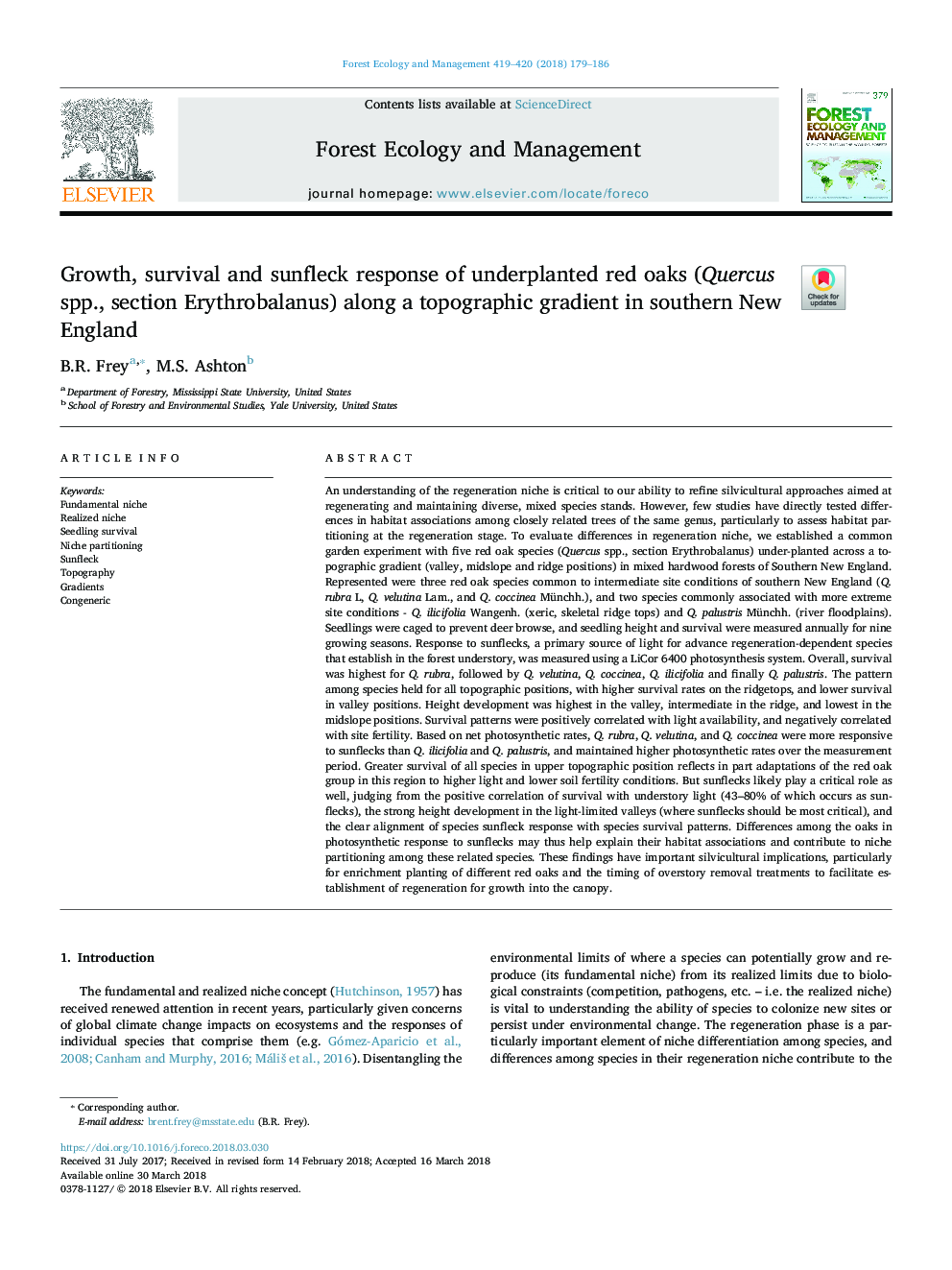| کد مقاله | کد نشریه | سال انتشار | مقاله انگلیسی | نسخه تمام متن |
|---|---|---|---|---|
| 6541716 | 1421340 | 2018 | 8 صفحه PDF | دانلود رایگان |
عنوان انگلیسی مقاله ISI
Growth, survival and sunfleck response of underplanted red oaks (Quercus spp., section Erythrobalanus) along a topographic gradient in southern New England
دانلود مقاله + سفارش ترجمه
دانلود مقاله ISI انگلیسی
رایگان برای ایرانیان
کلمات کلیدی
موضوعات مرتبط
علوم زیستی و بیوفناوری
علوم کشاورزی و بیولوژیک
بوم شناسی، تکامل، رفتار و سامانه شناسی
پیش نمایش صفحه اول مقاله

چکیده انگلیسی
An understanding of the regeneration niche is critical to our ability to refine silvicultural approaches aimed at regenerating and maintaining diverse, mixed species stands. However, few studies have directly tested differences in habitat associations among closely related trees of the same genus, particularly to assess habitat partitioning at the regeneration stage. To evaluate differences in regeneration niche, we established a common garden experiment with five red oak species (Quercus spp., section Erythrobalanus) under-planted across a topographic gradient (valley, midslope and ridge positions) in mixed hardwood forests of Southern New England. Represented were three red oak species common to intermediate site conditions of southern New England (Q. rubra L, Q. velutina Lam., and Q. coccinea Münchh.), and two species commonly associated with more extreme site conditions - Q. ilicifolia Wangenh. (xeric, skeletal ridge tops) and Q. palustris Münchh. (river floodplains). Seedlings were caged to prevent deer browse, and seedling height and survival were measured annually for nine growing seasons. Response to sunflecks, a primary source of light for advance regeneration-dependent species that establish in the forest understory, was measured using a LiCor 6400 photosynthesis system. Overall, survival was highest for Q. rubra, followed by Q. velutina, Q. coccinea, Q. ilicifolia and finally Q. palustris. The pattern among species held for all topographic positions, with higher survival rates on the ridgetops, and lower survival in valley positions. Height development was highest in the valley, intermediate in the ridge, and lowest in the midslope positions. Survival patterns were positively correlated with light availability, and negatively correlated with site fertility. Based on net photosynthetic rates, Q. rubra, Q. velutina, and Q. coccinea were more responsive to sunflecks than Q. ilicifolia and Q. palustris, and maintained higher photosynthetic rates over the measurement period. Greater survival of all species in upper topographic position reflects in part adaptations of the red oak group in this region to higher light and lower soil fertility conditions. But sunflecks likely play a critical role as well, judging from the positive correlation of survival with understory light (43-80% of which occurs as sunflecks), the strong height development in the light-limited valleys (where sunflecks should be most critical), and the clear alignment of species sunfleck response with species survival patterns. Differences among the oaks in photosynthetic response to sunflecks may thus help explain their habitat associations and contribute to niche partitioning among these related species. These findings have important silvicultural implications, particularly for enrichment planting of different red oaks and the timing of overstory removal treatments to facilitate establishment of regeneration for growth into the canopy.
ناشر
Database: Elsevier - ScienceDirect (ساینس دایرکت)
Journal: Forest Ecology and Management - Volumes 419â420, 1 July 2018, Pages 179-186
Journal: Forest Ecology and Management - Volumes 419â420, 1 July 2018, Pages 179-186
نویسندگان
B.R. Frey, M.S. Ashton,